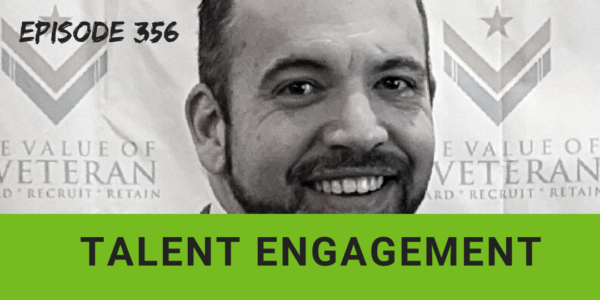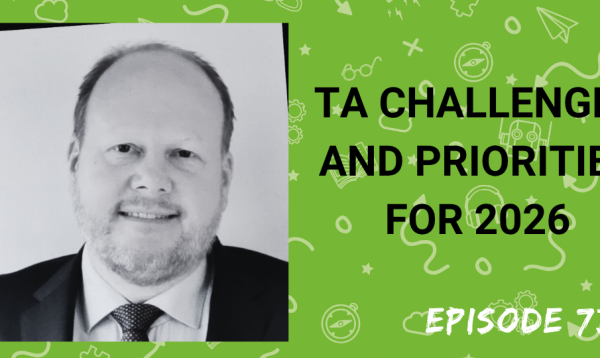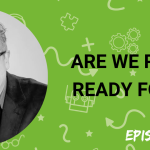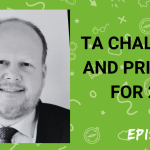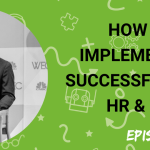Building and engaging with talent pipelines has been something we have been discussing for years, but it has always surprised that there are so few employers who do it well and even fewer that do it over extended periods. Technology, recruiting and communication have evolved significantly over the last two years, opening up opportunities for companies to devise very sophisticated pipelining and engagement strategies to help address resourcing challenges such as diversity hiring and skill shortages.
So who is doing this well, and how are they doing it?
My guest this week is Jason Boone, Diversity & Military Outreach Leader at Lockheed Martin. Lockheed Martin has a long-term talent pipeline strategy that sees them engage some communities of talent for 3 to 8 years before hiring.
In the interview, we discuss:
▪ The recruiting challenges at Lockheed Martin
▪ Investing in the emerging workforce
▪ Long term engagement strategies to increase diversity
▪ The role of time and touchpoints in building the brand, creating relationships, driving efficiency and improving offer acceptance
▪ Content strategies
▪ Time focused candidate-centric resources.
▪ The most surprising hiring success
▪ The role of technology
▪ Pushing talent across the enterprise
▪ Mashing up strategies and technologies
Listen to this podcast in Apple Podcasts.
Transcript:
Matt Alder [00:00:00]:
Support for this podcast comes From Avature, the AI powered total talent platform trusted by 110 of the Fortune 500 from initial candidate engagement. Through onboarding, talent mobility and performance management, Avature enables organizations to meet their unique needs while delighting and engaging all stakeholders. Just listen to what Nilesh Boote, Director of recruitment at L’Oreal, has to say.
Nilesh Boote [00:00:27]:
The solutions that we have created are so specific to L’Oreal that it just.
Nilesh Boote [00:00:31]:
Feels like a team sitting outside of.
Nilesh Boote [00:00:33]:
L’Oreal and working for us. If you sign up with Avature, it’s.
Nilesh Boote [00:00:37]:
For sure signing up with a company.
Nilesh Boote [00:00:39]:
With whom you will be really able to design solutions the way you want and also embark on a journey where innovation is at the core.
Matt Alder [00:00:50]:
Visit avature.net and discover why global leaders like L’Oreal join use Avature to power their recruiting and talent management strategies.
Matt Alder [00:01:17]:
Hi everyone, this is Matt Alder. Welcome to episode 356 of of the Recruiting Future podcast. Building and engaging with talent pipelines has been something we’ve been discussing for years, but it’s always surprised me that there are so few employers who do it well and even fewer that do it over extended periods of time. Technology, recruiting and communication have evolved significantly over the last two years, opening up opportunities for companies to devise very sophisticated pipelining and engagement strategies to help address resourcing challenges such as diversity, hiring and skill shortages. So who is doing this well and how are they doing it? My guest this week is Jason Boone, diversity and military outreach leader at Lockheed Martin. Lockheed Martin has a long term talent pipeline strategy that sees them engage some communities of talent for three to eight years before hiring. There are some hugely valuable takeaways in this must listen interview. Hi Jason and welcome to the podcast.
Jason Boone [00:02:26]:
Welcome Matt. Thanks for having me.
Matt Alder [00:02:29]:
An absolute pleasure to have you on the show. Could you just introduce yourself and tell us what you do?
Jason Boone [00:02:33]:
Certainly. So my name is Jason Boone and I’m currently the diversity and military outreach lead at Lockheed Martin, which in the short of it means I have the really wonderful opportunity of reaching out and building relationships and building talent pipelines with diverse communities across our talent segments. And that includes people of color, women in technology, the LGBTQ community and the veteran community and all doing that for Lockheed Martin, which is one of the world’s oldest and most responsible respected aerospace companies.
Matt Alder [00:03:01]:
Fantastic stuff. That sounds like a very busy job.
Jason Boone [00:03:03]:
It certainly is. It keeps us hopping, especially with the growth in hiring we’ve had over the last several years.
Matt Alder [00:03:09]:
So tell us a little bit more about some of the challenges that you face when it comes to hiring.
Jason Boone [00:03:13]:
Absolutely. So one of the challenges that I think many companies are facing right now is finding experienced professionals and particularly those that can grow the innovation culture in their company. So Lockheed Martin is a company with 100 plus years of innovation history. So we need individuals that are going to contribute to that. And much of that formula that creates innovation is lenses of different perspectives. Ultimately that’s diversity. So as we’re looking to build our diverse pipelines and find individuals with many different backgrounds that bring many different lenses to our environment, that sometimes is an easier task when we’re hiring right out of college. But as we look for experienced professionals, that gets to be a tougher job. And then with that is how do we do so at scale, which now pulls in technology implementation. And it’s interesting is I remember just back maybe a month or so ago you had Eightfold on and they talked about the challenges with technology implementation. A lot of the focus on change management and stakeholder buy in. And we’ve been having those same challenges. How do we get the users, the consumers of our talent, to buy in to the new methods that we are implementing, the technologies that we’re bringing in? Because to hyper personalize to scale as we engage with talent, we have to leverage technology. And we have a robust technology platform, starting with Avature as our backbone, leveraging virtual event platforms, automated interview scheduling tools. So really robust. And every time we bring one of those tools in, adoption is sometimes a challenge. So communication and change management for that stakeholder buy in is vital. And then what we really see is the main solution for that is a long term strategy. So nobody feels that it is flavor of the month that our organization knows that just as we’ve been building airplanes for 100 years, we’re going to be building diverse talent pipelines for many years to come. And a lot of that strategy is to focus on what’s in it for them and that approach for our candidates as well.
Matt Alder [00:05:15]:
There’s already so much stuff there for three or four, three or four podcasts. So I’m desperate to know more about what you’re doing to solve some of these challenges through the long term engagement plan that you have with the diversity and inclusion. Because I think you’re doing some, you’re doing some really interesting work there.
Jason Boone [00:05:34]:
Absolutely, Matt. So As I mentioned, 100 years we’ve been building some really revolutionary aircraft like the SR71, the fastest jet ever built. And I tell people all the time, I can’t build the next aircraft. I’m not building hypersonic technology. But I can build innovative ways to, to bring talent into our organization. And when I think about that, a hundred years that Lockheed Martin’s been around and the hope for a hundred years going forward, that means that long term isn’t about six months and it’s not even about a couple years. When I talk about a long term engagement strategy, I’m looking at three to eight years of a workflow enabled, technology driven, content focused model. So there’s certainly a lot there to unpack. But sometimes people look at me and say, three to eight years, what does that look like? What’s the value and how do you do that? And even why? And for me, it’s not about the talent that I’m going to hire tomorrow or that our organization is going to hire tomorrow, but it’s about the talent that we’re going to hire long term. So if I think about our diversity populations, I love a couple examples. So one is our STEM scholarship. So we invest in the emerging workforce of our country. So we have a STEM scholarship program. And it’s really a great program. 200 new applicants a year receiving the scholarship. And part of the priority for that scholarship selection is diverse individuals, people of color, women, and first generation college students. So the talent pool is already a naturally diverse talent pool. Now here’s where we have fun with it. Our college team does a great job of engaging the recipients of those scholarships. That’s easy. And everybody’s like, hey, we know how to do that, Jason. But I looked and I said, hey, what about the 7,000? Yep, 7,000 applicants who applied to the scholarship but didn’t receive them. I looked at that population, I said, wait a minute, these are good students. You know, they maybe didn’t receive the scholarship because we have a limit of 200, but they’re interested in a STEM career. Many of them are in that diverse population groups. They’re excited and they’ve done a great job in their high school career. How do I engage them for the long term? What’s that look like? So when I talk about that eight year engagement model, year one is their high school senior year because that’s when they applied. Now year two through five is their college career. Our model, it builds an engagement strategy that focuses on understanding them, their ever changing career focus through college. Because we all know majors change, graduation dates change, colleges change, where you want to live changes all these things. Change. So we leverage AVATURE in a portal driven approach. So we’re collecting data and confirming data over that time in college to understand when are they graduating, where do they want to work skill sets for that diverse population group. Then if we can hire them out of college, that’s awesome. But we know we may not hire them all out of college. So years six, seven and eight, we’re continuing to manage the relationship and engage and build our brand with now what are experienced professionals? They’re year two, three years out of college now they’re that experienced professional population. We’ve built a brand with them. They know who Lockheed Martin is, they know the value we place on diversity. They know the opportunities they have to apply their STEM education. And now a couple years of experience. So that’s one of my favorites. And a brief mention a similar model is what we do with Girls Inc. And Girls who Code. So organizations that are bringing young ladies into software development environment. So a desperate need for software engineers. And if we can bring and have a relationship with those young ladies into that same long term model, it gets us there. And we use the term candidate journey and full credit to our space organization, Lockheed Martin Space for creating that term of a candidate journey. And it takes from what we call emerging talent. So those individuals coming out of high school or in trade schools, all the way through their experience, professional career. And my last point on the data side of this, we found clearly that time and touch points are building brand, they’re creating relationships. We all know this. But what’s exciting is building efficiency in the hiring timeline and it’s even increasing the offer acceptance rate. We’re seeing a direct correlation between the candidates that we engage with over a greater period of time. The more touch points we have with those candidates and when I say touch, it’s giving them valuable resources. We’re increasing our accept rate of those candidates and that ultimately that produces a lower cost to hire, a faster time to fill. And those are metrics that talent acquisition leaders and the business care about.
Matt Alder [00:10:02]:
And that’s absolutely amazing in terms of a strategy. It’s not very often that I talk to an organization that is really thinking strategically that that long term about talent acquisition. Just want to unpack some of the things that you do within that, that strategy. So you talked about time and touch points and content. How do you keep someone’s attention over that, that, that time period and how do you enhance how they, how they feel about your brand?
Jason Boone [00:10:32]:
Absolutely. The content is really key to that because we don’t want to just Be another company that’s sending them check out this job. And I refer to that all the time. That’s historically, hey, you’ve registered for a talent community. Check out these new career opportunities. Look at what’s going on here. We don’t want to focus on that. So I probably mentioned the term earlier, what’s in it for them? And many of us have heard the old phrase the WIFM what’s in it for me? And we flip that and what’s in it for them in our approach to our content. So what that means is we shifted away from hey, look at our jobs, here’s what we have for you, here’s what even here’s what we’re doing and shifted about time focused centric to the candidate of resources that are going to assist them. So what I mean by that in a few examples is if somebody is getting to a point and I’m going to use the example of that individual that’s coming near the end of their college career that we’ve been engaging now for three or four years, the start of their senior year, the summer before their senior year, we’re sending them videos that walk them through ways to tailor their resume for an opportunity and showing them what to look for and the ways to build a resume unique for each opportunity. Now we’re also building that video on what we like to see in a resume. So we’re helping a candidate build a quality resume and doing so in a way that our talent teams are able to quickly review the resume and understand who those best candidates are. But the focus is a resource to the candidate at the same time. As we know busy interview season is coming up for those individuals. And again our focus is understanding the timeframe that that individual. So it’s tailored for that individual. If it’s a December grad, they’re getting information in a different timeframe. If they are an individual that is looking for their next career and they’ve told us this is when I’m available. All of our communication, that content is focused on them and their timeframe. We’re sending them guides on how to interview and not just the kind of the hey, ask great questions or how to answer what your strengths and weakness are. But we’re talking to them. This is what a star format sounds like. This is how you guide your answer. And video is clearly king in content. So when we’re sending it, no one wants to read a two page article about a star format interview answer. But if they can watch a great example of the star format being Presented, that’s a resource that’s value. The other piece with that is we’re leveraging the technology to create content that’s value for the team. So what I mean by that is early in our process we understand the career focus. And so through an adversary driven registration page, we’re asking them about their skill focused career. It’s structured data, so it’s a dropdown list. So for example, somebody selects AI and Autonomy as their career interest. Now we capture that data, we build the list filters within our communication to understand if this person selected AI and Autonomy, we’re going to send them content that’s relevant to that topic. So if we have a new enhancement to an AI technology, or we’re seeing contracts and developments within Autonomy, or even a fun one, as we were hosting a competition to build and fly autonomous rotary wing aircraft, we’re sending that information to the candidates selected AI and Autonomy. Now that doesn’t necessarily seem hard to send content relevant to a candidate, but because we’re capturing structured data from the candidate, confirming that data throughout the timeframe, and using a list filter to automatically send the content that’s relative in the candidate. It’s a set it and forget it model. And I’m a fan of the old infomercial where he talked about set it and forget it for his rotisserie. And I like to do the same thing. If I can give great hyper personalized content without having to have our talent team go in and change and update that content over time, that makes our whole team more efficient and at the same time it provides content that the candidates want to read. So now we’re not just a brand of hey, that’s Lockheed Martin. It’s, that’s Lockheed Martin. That helped me with resources and a guide and interesting content through my career journey.
Matt Alder [00:14:39]:
Does this continue? You know, you sort of mentioned sort of a couple of years out of college and a kind of an eight year cycle. Does this, do you continue this into people’s careers or is that kind of where that process stops?
Jason Boone [00:14:52]:
You know, and that’s, that’s probably my favorite piece. Matt and I talked a lot about that journey through high school and then into college. But as I mentioned, the beginning, experienced professional talent is one of our greatest challenges. So it absolutely continues well past that. And a quick example of where we do that is a conference called bea, the Black Engineer of the Year Award. We’ve been a sponsor of BEA for many, many years. It’s a well established organization and the focus is college students. But what we recognized was Every year we’ve been attending the conference, we’re collecting candidate data. We know who attended. There were often students at HBCUs across the country and we know when they attended. So now I know if I met with a student in 2010 that attended the BEA conference and they were student at that time and it’s 2021 at a minimum, that person is going to have. And do my quick math, 14 years of experience. It’s a very experienced professional. No, seven years of experience. Sorry for my math there. So very experienced professionals. And so we’re looking at when did they attend as a college student and now advancing forward. So now they’re an alumni and we can understand their graduation date and extrapolate out that this person graduated in 2016. They now have five years of experience. So taking that a step further, we’re not sending them career opportunities that are for early career and we’re also not talking to them about executive opportunities. We’re talking to them about mid career roles where they’re advancing their leadership skills, still having their hands on the technology. So understanding when they engaged and where they were in their life and advancing it forward and tailoring that communication. So now with that Black Engineer Year award, the BEA conference, we’re engaging a five year experience professional. Well after our first engagement with content that’s tailored to where they are in their career.
Matt Alder [00:16:50]:
You mentioned a lot of the kind of the great results and outcomes that you got from your, from this strategy. Which part of that success has surprised you the most? What’s sort of the most interesting thing that’s happened?
Jason Boone [00:17:02]:
You know, I was just mentioning this to somebody the other day and I said it to them. We were on a video call and I saw their face. It was just kind of shocked. And that is that our greatest hire success is with individuals that register for our events and don’t attend.
Matt Alder [00:17:20]:
Wow.
Jason Boone [00:17:20]:
And at first they were like, wait, what? And then I don’t know if that was might have been your first response, Matt, but what I mean by that, and this is why I also love virtual events for experienced professionals. So we were forced into virtual events in a lot of ways. But I also recognize, you know, virtual events provide us anonymity for the experienced professional. They’re not hanging around a career fair where they’re going to run into their boss or their coworker. But more importantly, with our virtual event platform, I see who registers and I see who attends. Now historically we might have said okay, if somebody didn’t attend, they’re not that interested in a career with us. But, and I got to give credit to one of our divisions, Missiles and fire control is first, who identified this. And they said, wait a minute. They registered for an event because they were interested in Lockheed Martin. And the one that they caught, it was a cyber symposium where we were talking about advances in cyber kill chain and our technology around cyber. But they didn’t attend. And they said, wait a minute. They didn’t attend because they’re professionals that are working, they care about their deliverables, they’re loyal to their current employer, they’re delivering on the mission that they have today. Doesn’t mean they’re not interested in advancing their career, but they, they’re actively engaged in their career because many events are during the workday. Well, somebody that has those characteristics of engaged with their projects, loyal, committed, those are the things that we absolutely want out of any of our employees. So they started a process of saying, hey, let’s engage those individuals and not say, hey, we missed you or you weren’t able to make it. We started right off by acknowledging we understand your busy schedule, the deliverables that you have and the importance of your work. So we complimented them for their career. Then we said, now let’s find an opportunity to engage with you individually at a time that works for you. So we built in a link where they can automatically schedule a screening with one of our sources through the automated interviewing technology. The scheduling technology is there, so that’s an easy integration with multiple technologies. So when we track that forward and if we look at the offer and hire rate of the candidates that attended an event versus those that registered but didn’t attend, we’re getting a greater engagement and ultimately a greater offer accept rate from the registered but non attended participants.
Matt Alder [00:19:40]:
It’s just brilliant that you can track that, that you’ve got that level of data to spot these patterns.
Jason Boone [00:19:45]:
And it’s something we would have never had at an old career event in person. I love in person. Don’t get me wrong, I like shaking hands and talking to people. But there we didn’t know who didn’t walk up to our booth. Maybe they got close, they looked, they saw some interest, but there was a line and they stepped away. Now with the technology and the virtual events, the platform tells us, here’s who registered, here’s who didn’t attend, here’s what booth they chatted in. So now we even understand what was their interest during the event at what booth. The data is so valuable.
Matt Alder [00:20:14]:
You’ve sort of mentioned technology all the way, all the way. Through the conversation. But I just wanted to to drill down a little bit to find out a little bit more about the technology that supports this and the adoption challenges that you were talking about. So talk us through technology’s role in all this.
Jason Boone [00:20:29]:
Absolutely. So we use Avature as our back end CRM. So that is really the backbone for our candidate engagement. We have a separate ats, we have a separate virtual events platform, but we do use Avature for their Avature events model, their DNA model. So we use Avature quite a bit and we do like the integration between technologies. And I don’t know that there’s a recruiter or a talent professional that doesn’t have to work with multiple technologies within their entire TA tech stack. So that’s nice that we can integrate all those technologies together. So Avature is that backbone. And where we initially had some challenges of hey, this is different than what we came from, so that’s a piece. So that was the first step of we needed to bring all the stakeholders to buy in. We worked through that. The change management was there. Then where we’ve had some of the greatest successes is customizing. And sometimes when we talk about technology, customization is a dirty word. But we customized our instance to empower the business areas to do what’s right for them. So as I mentioned, our space business area calls it a candidate journey and they build that candidate journey and it’s able to to create an experience that is ideal for their talent teams. We are a decentralized talent environment where Lockheed Martin’s space focuses on those business areas. Then we wanted to leverage R and D with this. And when I say R and D, I mean rip off and duplicate. If we have a workflow with an Avature that’s working really well for space, we wanted our rotary emission systems division to take that technology, to take that model, make the customizations that they need to do and then implement it in their environment. So we went with a model there. The candidate can flow across multiple opportunities. We build in the filters to make sure they’re not being inundated with multiple communications at the same time because that hurts our brand. But then it’s tailored for every business area then. And I’m going to kind of reference right back to that because I really loved the session you had a couple weeks ago with Eightfold and they talked about the customer adoption. We recognized that our customer, because we’re the sourcing team that really drives Avature, our customer was the requisition owners, those recruiters that own and fill the Recs and the hiring managers. So if we’re going to have success in our adoption of our technology, we need to get that customer to use the talent pools we’re creating. So I always say, fishing from a stock pond, well, if I build it, if I stock this pond, but no one goes there to fish. There’s no point, there’s no value. We all know that. So I needed to make sure that we were not only creating this stocked pond, but my favorite part is to push the right technology. And I think back to, we apply to a job and I’m going to go back to the early days of online applications in the 90s, and you say, hey, thanks for applying. You weren’t a fit, where you’re going to keep your resume for the future. But how often was somebody actually going back and looking at that, and how often was someone pushing an applicant across an environment? Well, here’s where we take the technology together. Not only do we use structured data to understand the skill sets and timeframes that a candidate’s looking for an opportunity, but we’re now polling our internal customers, the recruiters and the hiring managers say, what skill sets do you hire for the most and what are the timeframes that you’re looking to hire? So now we’re able to push. So we, we use the avature workflow to bring together the right candidate to the right hiring teams and marry them at the right time and push that talent across the enterprise. So literally, when I say push it, a distribution of talent that would be an easy example from it is we attended or we hosted a women in technology forum and we can push out to the environment here, women that have this skill set that you’re looking to hire that came from this form we hosted and are available now and then in six months for those that are available at that time to push that talent out to the right time to them. So when we can push the right talent to the right hiring team at the right time, we’re seeing an increase in leveraging the talent pools that we created.
Matt Alder [00:24:44]:
There’s so much more stuff that I want to talk to you about around this. I’m finding it absolutely fascinating. But just, I mean, in the interest of time, a final question. What’s next? What are you, what are you going to be focusing on over the next sort of 12 to 18 months?
Jason Boone [00:24:58]:
So this is, and I’m going to use the fun term because I think about what’s next. So we had military hiring down really well, and now we’re growing diversity and we’re able to take some of our successes from military and focus on diversity talent pipelines. Now it’s about a mashup of pipelines and strategies. And I love the term just as much as I love a good mashup song, I love to do it with our pipelines and our strategies. So what I mean by that is we need cleared professionals. So individuals working on our projects that have security clearances, that’s a critical need for us. We also want to have those individuals I mentioned that have multiple perspectives, can see problems through a different lens and build diversity pipelines. So then we said, what if we can marry these two together? And the simple example comes about, what about the associations like the Tuskegee Airmen, which is individual of black professional pilots. So individuals that have that military background, which is often clear talent and are interested in the aerospace industry, that mashup of talent. And we even saw the same thing with there’s organizations for women that graduated from the US Air Force Academy. So now we’re able to mash up cleared professional engineers because almost everyone at the Air Force Academy is an engineer that have the clearances, have the skills, understand the mission, and are the women in technology that we want to bring onto our programs and gain that diverse perspective. So mashing up those talent pipelines, then we wanted to go a step further and mash up our referral programs with our diversity focus. And where I’m loving this is, I’ll start with this. We use the term brg. I know a lot of companies use ERG for employee resource group. We use the term business resource group. So where our employees and our business partner together to grow the success of the organization. Those are valuable organizations. We participate in the culture, the camaraderie, the shared growth within the organization. And what if we mash up our referral programs with our diversity focused BRGs and we’re growing specific talent pools of referred individuals from our business resource groups. That mashup is a really exciting one for us to see how that success goes and to let those, the members of the BRG know not only do we value you for your organization, but we value the individuals in your network and how in your interest in bringing those individuals into Lockheed Martin. And then the last mashup is a combination of the AI based matching tools. So like eightfolder, we have our own AI based matching tool and mash that up with traditional filters because I think we all know sometimes keyword matching or resume matching has some flaws and it could miss sometimes experience levels or it could miss location interest. So we’re taking this blend of understanding where does the candidate want to go? Because where do you want to go is really hard to get from a resume because it’s usually not stated there. But if we can ask that question through part of the candidate journey and then marry that up with our matching technology, we now get an even greater experience to recommend the right opportunity for skill set with the right location or the right clearance or the right experience level to that candidate. And so now we get the right candidates, apply to the right roles and increase the success that we have. So mashing up the AI with the candidate driven responses gives us a better success rate.
Matt Alder [00:28:31]:
Jason thank you very much for talking to me.
Jason Boone [00:28:33]:
Matt, it has absolutely been a pleasure. I enjoy the podcast all the time. I look forward to more than I’m going to hear and I certainly look forward to connecting to professionals in the community and in the talent teams.
Matt Alder [00:28:45]:
My thanks to Jason Boone. You can subscribe to this podcast in Apple Podcasts, on Spotify or via your podcasting app of choice. Please also follow the show on Instagram. You can find us by searching for Recruiting Future. You can search all the past episodes@recruiting future.com on that site. You can also subscribe to the mailing list to get the inside track about everything that’s coming up on the show. Thanks very much for listening. I’ll be back next time and I hope you’ll join me.

